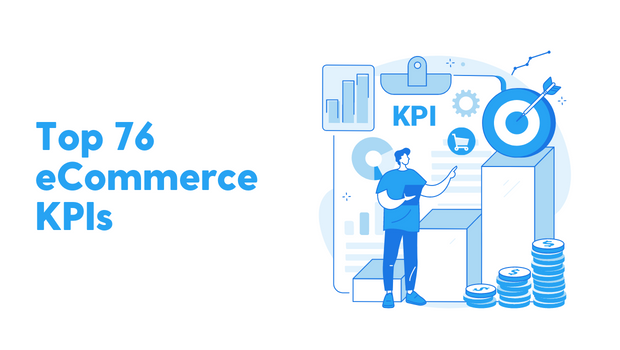eCommerce KPIs
As an eCommerce business owner, you know how important it is to be able to measure and track the performance of your business. From understanding customer behavior to optimizing operations, the right KPIs (Key Performance Indicators) and metrics can make all the difference. But with so many metrics to choose from, it can be overwhelming to figure out which ones are essential and how to best leverage them. That’s why we’ve put together this definitive guide to help you better understand and leverage the top 75 eCommerce KPIs for your store and mobile app or your B2C or B2B business. Here, you’ll find everything you need to know about the industry’s most important metrics and how to use them to optimize your business and reach your goals. So, let’s get started!
List of eCommerce KPIs and Metrics
- Traffic volume
- Unique visitors
- Bounce rate
- Average time on site
- Page views per visit
- New vs. returning visitors
- Customer demographics
- Mobile vs. desktop traffic
- Traffic sources (e.g. organic, paid, referral)
- Social media engagement
- Email open rate
- Email click-through rate
- Conversion rate
- ROAS
- CTR
- Sales volume
- Average order value
- Gross margin
- Net profit
- Return on investment
- Cost per acquisition
- Customer acquisition cost
- Customer retention rate
- Customer churn rate
- Customer satisfaction score
- Customer loyalty rate
- Cart abandonment rate
- Checkout abandonment rate
- Payment acceptance rate
- Order abandonment rate
- Order completion rate
- Order cancelation rate
- Product performance (e.g. best-selling, worst-selling)
- Product categories (e.g. most popular, least popular)
- Product returns
- Product reviews
- Product ratings
- Product upsell rate
- Product cross-sell rate
- Product innovation rate
- Order processing time
- Order fulfilment time
- Order delivery time
- Product availability
- Product pricing
- Product margins
- Product packaging
- Product delivery
- Inventory accuracy
- Inventory turnover rate
- Inventory carrying cost
- Inventory stock-out rate
- Inventory lead time
- Supplier performance
- Supplier diversity
- Supplier delivery time
- Supplier quality
- Supplier pricing
- Warehouse efficiency
- Warehouse utilization rate
- Warehouse capacity
- Warehouse cost per unit
- Warehouse labor cost
- Warehouse turnover rate
- Shipping cost
- Shipping time
- Shipping accuracy
- Shipping damage rate
- Return shipping cost
- Return processing time
- Return rate
- Customer lifetime value
- Customer service cost
- Complaint resolution time
- Complaint rate
- Customer service response time
- Customer service satisfaction score
- Customer service resolution rate
There are many different eCommerce KPIs and metrics that businesses can track, each with its own unique importance and relevance to different business functions. For example, customer lifetime value (CLV) is a key metric that is important for both the marketing and finance teams. CLV is the estimated total value that a customer will bring to a business over the course of their relationship with the company, and it can be used to optimize marketing and sales efforts and make informed financial decisions.
In this blog, we will explore a variety of eCommerce KPIs grouped by the relevant business function that eCommerce brands can use to measure and analyze the performance of their online stores. From sales and conversion rates to website traffic and social media engagement, these metrics provide valuable insights into the health and success of an eCommerce business.
eCommerce Marketing KPIs
- Traffic volume: Traffic volume is the total number of visitors to a website over a given period. It can be measured daily, monthly, or over any other time frame.
Formula: Traffic volume = Total number of visitors - Unique visitors: Unique visitors are individuals who visit a website at least once during a specified time frame. They are counted only once, regardless of how many times they visit the website.
Formula: Unique visitors = Number of unique visitors - Bounce rate: Bounce rate is the percentage of visitors to a website who leave the site after viewing only one page. It is a measure of how effective a website is at retaining visitors and encouraging them to explore more pages on the site.
Formula: Bounce rate = (Number of bounces / Number of visits) x 100%
Also, read: Fix Incorrect Bounce Rates - Average time on site: Average time on site is the average amount of time that visitors spend on a website during a single visit. It is a measure of how engaging a website is and how well it keeps visitors interested.
Formula: Average time on site = Total time spent on site / Number of visits - Page views per visit: Page views per visit is the average number of pages that visitors view on a website during a single visit. It is a measure of how much content on a website visitors are consuming.
Formula: Page views per visit = Total number of page views / Number of visits - New vs. returning visitors: New visitors are individuals who are visiting a website for the first time, while returning visitors are individuals who have visited the website before. This KPI helps to understand the proportion of new vs. returning visitors to a website.
Formula: (Number of new visitors / Total number of visitors) x 100% = Percentage of new visitors (Number of returning visitors / Total number of visitors) x 100% = Percentage of returning visitors - Customer demographics: Customer demographics refer to the characteristics of a website’s visitors, such as their age, gender, location, and income level. This helps to understand the types of customers who are visiting a website.
Also, read – Customer Segmentation - Mobile vs. desktop traffic: Mobile vs. desktop traffic refers to the proportion of visitors to a website who are accessing the site from a mobile device (e.g. smartphone, tablet) versus a desktop computer. This KPI helps to understand how visitors are accessing a website and whether it is optimized for mobile devices.
Formula: (Number of mobile visitors / Total number of visitors) x 100% = Percentage of mobile traffic (Number of desktop visitors / Total number of visitors) x 100% = Percentage of desktop traffic - Traffic sources: Traffic sources refer to the ways in which visitors are finding and accessing a website. Common traffic sources include organic search (e.g. from search engines like Google), paid search (e.g. from paid advertising campaigns), referral traffic (e.g. from other websites linking to the site), and direct traffic (e.g. visitors typing the website’s URL directly into their browser). This KPI helps to understand the most effective channels for driving traffic to a website.
- Social media engagement: Social media engagement is the level of interaction that a website’s content receives on social media platforms. It can be measured by the number of likes, comments, shares, and other actions that a website’s content receives on social media. This KPI helps to understand how effective a website’s social media presence is at driving traffic and engagement.
Also, read – Social Commerce - Email open rate: Email open rate is the percentage of emails that are opened by recipients. It is a measure of how effective an email campaign is at capturing the attention of its intended audience.
Formula: Email open rate = (Number of email opens / Number of emails sent) x 100% - Email click-through rate: Email click-through rate is the percentage of recipients who click on a link within an email. It is a measure of how effectively an email campaign is driving traffic to a website or other desired action.
Formula: Email click-through rate = (Number of clicks / Number of emails sent) x 100% - Conversion rate: Conversion rate is the percentage of visitors to a website who complete a desired action, such as making a purchase or filling out a form. It is a measure of how effective a website is at converting visitors into customers or leads.
Formula: Conversion rate = (Number of conversions / Number of visitors) x 100%Note: A conversion can be any desired action that a website wants visitors to take, such as making a purchase, filling out a form, signing up for a newsletter, or downloading a white paper. The specific definition of a conversion will depend on the goals of a website and the actions that it wants visitors to take.
Also, read: Conversion Rate Optimization - Return on ad spend (ROAS): This is the amount of revenue that a business generates from its advertising efforts, divided by the amount it spends on advertising. A high ROAS indicates that the business is generating a good return on its advertising investment.
- Click-through rate (CTR): This is the percentage of people who click on an ad, divided by the number of people who view the ad. A high CTR indicates that the ad is relevant and effective at driving traffic to the business’s website.
eCommerce Sales KPIs
- Sales volume: The total amount of sales generated by the business over a given period. This can be measured in units sold or monetary value.
Formula: Sales volume = units sold x price per unit - Average order value: The average amount spent by a customer on each purchase. This is calculated by dividing the total sales by the number of orders.
Formula: Average order value = total sales / number of orders - Conversion rate: The percentage of website visitors who complete a desired action, such as making a purchase or filling out a form. This is calculated by dividing the number of conversions by the number of total visitors and multiplying by 100.
Formula: Conversion rate = (number of conversions / number of visitors) x 100 - Customer lifetime value: The total amount of money a customer is expected to spend on a business’s products or services over the course of their relationship with the business. This can be calculated using a variety of methods, such as the customer acquisition cost method (which divides the customer lifetime value by the customer acquisition cost) or the discounted cash flow method (which takes into account the time value of money).
- Gross margin: The profit a business makes after deducting the cost of goods sold (COGS) from the revenue.
Formula: Gross margin = revenue – COGS - Net profit: The profit a business makes after all expenses have been accounted for.
Formula: Net profit = revenue – expenses - Return on investment (ROI): The profit or loss made on an investment, expressed as a percentage. This is calculated by dividing the net profit by the cost of the investment and multiplying by 100.
Formula: ROI = (net profit / cost of investment) x 100 - Cost per acquisition (CPA): The cost of acquiring a new customer, calculated by dividing the total marketing and sales expenses by the number of new customers acquired.
Formula: CPA = total marketing and sales expenses / number of new customers - Customer acquisition cost (CAC): The total cost of acquiring a customer, including marketing, sales, and product development expenses. This can be calculated by dividing the total spend by the number of new customers acquired.
Formula: CAC = total spend / number of new customers - Customer retention rate: The percentage of customers who continue to do business with a company over time. This is calculated by dividing the number of customers at the end of a given period by the number of customers at the beginning of the period and multiplying by 100.
Formula: Customer retention rate = (number of customers at end of period / number of customers at beginning of period) x 100
Also, read: - Customer churn rate: The percentage of customers who stop doing business with a company over a given period of time. This is calculated by dividing the number of customers lost during the period by the total number of customers at the beginning of the period and multiplying by 100.
Formula: Customer churn rate = (number of customers lost during period / total number of customers at beginning of period) x 100
Also, read: - Customer satisfaction score: A measure of how satisfied customers are with a business’s products or services, typically expressed as a percentage or on a scale of 1 to 10. This can be determined through customer surveys or other methods.
- Customer loyalty rate: The percentage of customers who continue to do business with a company over time, expressed as a percentage. This can be calculated by dividing the number of loyal customers by the total number of customers and multiplying by 100.
Formula: Customer loyalty rate = (number of loyal customers / total number of customers) x 100 - Cart abandonment rate: The percentage of shopping carts that are abandoned by customers before completing a purchase. This is calculated by dividing the number of abandoned carts by the number of initiated checkouts and multiplying by 100.
Formula: Cart abandonment rate = (number of abandoned carts / number of initiated checkouts) x 100Also,
read: Shopping Cart Abandonment - Checkout abandonment rate: The percentage of customers who abandon their purchases during the checkout process. This is calculated by dividing the number of abandoned checkouts by the number of initiated checkouts and multiplying by 100.
Formula: Checkout abandonment rate = (number of abandoned checkouts/number of initiated checkouts) x 100 - Payment acceptance rate: The percentage of orders that are successfully completed with a valid payment. This is calculated by dividing the number of orders with successful payments by the total number of orders and multiplying by 100.
Formula: Payment acceptance rate = (number of orders with successful payments / total number of orders) x 100 - Order abandonment rate: The percentage of orders that are abandoned by customers before being completed. This is calculated by dividing the number of abandoned orders by the total number of orders and multiplying by 100.
Formula: Order abandonment rate = (number of abandoned orders / total number of orders) x 100 - Order completion rate: The percentage of orders that are completed successfully. This is calculated by dividing the number of completed orders by the total number of orders and multiplying by 100.
Formula: Order completion rate = (number of completed orders / total number of orders) x 100 - Order cancelation rate: The percentage of orders that are canceled by customers or the business. This is calculated by dividing the number of canceled orders by the total number of orders and multiplying by 100.
Formula: Order cancelation rate = (number of canceled orders / total number of orders) x 100 - Product performance: A measure of how well a product is selling, either in terms of units sold or revenue generated. Best-selling products are those that have the highest sales volume or revenue, while worst-selling products are those that have the lowest sales volume or revenue.
- Product categories: A measure of how popular different product categories are with customers. Most popular categories are those that generate the most sales volume or revenue, while least popular categories are those that generate the least sales volume or revenue.
- Product returns: The percentage of products that are returned by customers. This is calculated by dividing the number of returned products by the total number of products sold and multiplying by 100.
Formula: Product returns = (number of returned products / total number of products sold) x 100 - Product reviews: The number of reviews left by customers for a product. This can be a useful indicator of customer satisfaction and can help to improve the product’s visibility and sales.
- Product ratings: The average rating given to a product by customers, typically expressed on a scale of 1 to 5 or 1 to 10. This can be a useful indicator of customer satisfaction and can help to improve the product’s visibility and sales.
- Product upsell rate: The percentage of customers who purchase a higher-priced or upgraded version of a product. This is calculated by dividing the number of upsells by the total number of sales and multiplying by 100.
Formula: Product upsell rate = (number of upsells / total number of sales) x 100 - Product cross-sell rate: The percentage of customers who purchase related or complementary products in addition to their initial purchase. This is calculated by dividing the number of cross-sells by the total number of sales and multiplying by 100.
Formula: Product cross-sell rate = (number of cross-sells / total - Product innovation rate: The rate at which a business introduces new products or updates existing products. This can be measured in terms of the number of new products launched per period or the percentage of the product line that is updated.
eCommerce Operations KPIs
- Order processing time: The amount of time it takes for a business to process an order, from the time the order is placed to the time it is ready to be shipped or picked up.
- Order fulfillment time: The amount of time it takes for a business to fulfill an order, from the time the order is placed to the time it is delivered or picked up.
- Order delivery time: The amount of time it takes for a business to deliver an order to the customer, from the time the order is placed to the time it is received by the customer.
- Product availability: The percentage of time that a product is in stock and available for purchase. This is calculated by dividing the total time a product is in stock by the total time the product is expected to be available and multiplying by 100.
Formula: Product availability = (total time in stock / total time expected to be available) x 100 - Product pricing: The cost of a product to the customer, including any discounts or promotions. Also, read: Pricing Strategy
- Product margins: The profit made on a product after deducting the cost of goods sold (COGS) from the product’s price.
Formula: Product margins = product price – COGS - Product packaging: The materials and methods used to package a product for shipping or in-store display.
- Product delivery: The process of getting a product to the customer, including the methods and carriers used.
- Inventory accuracy: The percentage of inventory that is accurately reflected in the business’s records. This is calculated by dividing the number of accurately recorded items by the total number of items and multiplying by 100.
Formula: Inventory accuracy = (number of accurately recorded items / total number of items) x 100 - Inventory turnover rate: The number of times a business’s inventory is sold and replaced over a given period of time. This is calculated by dividing the cost of goods sold (COGS) by the average inventory value.
Formula: Inventory turnover rate = COGS / average inventory value - Inventory carrying cost: The total cost of holding inventory, including storage, insurance, and financing costs.
- Inventory stock-out rate: The percentage of time that a product is out of stock. This is calculated by dividing the total time a product is out of stock by the total time the product is expected to be available and multiplying by 100.
Formula: Inventory stock-out rate = (total time out of stock / total time expected to be available) x 100 - Inventory lead time: The amount of time it takes to receive a new shipment of inventory from a supplier.
- Supplier performance: A measure of how well a supplier is meeting the needs of a business, including factors such as delivery times, quality of products or services, and pricing.
- Supplier diversity: The percentage of a business’s suppliers that come from diverse groups, such as minority-owned, woman-owned, or small businesses.
- Supplier delivery time: The amount of time it takes for a supplier to deliver products or services to a business.
- Supplier quality: A measure of the level of quality of products or services provided by a supplier.
- Supplier pricing: The cost of products or services provided by a supplier.
- Warehouse efficiency: A measure of how efficiently a warehouse is operating, including factors such as the speed of order processing and fulfilment, accuracy of orders, and utilization of space and resources.
- Warehouse utilization rate: The percentage of a warehouse’s capacity that is being used. This is calculated by dividing the total volume of products stored in the warehouse by the warehouse’s total capacity and multiplying by 100.
Formula: Warehouse utilization rate = (total volume of products stored / warehouse capacity) x 100 - Warehouse capacity: The total amount of space and storage available in a warehouse.
- Warehouse cost per unit: The cost of storing and handling each unit of product in a warehouse. This can be calculated by dividing the total warehouse expenses by the number of units stored.
Formula: Warehouse cost per unit = total warehouse expenses / number of units stored - Warehouse labor cost: The cost of labor associated with operating a warehouse, including wages and benefits.
- Warehouse turnover rate: The number of times a warehouse’s inventory is sold and replaced over a given period of time. This is calculated by dividing the cost of goods sold (COGS) by the average inventory value.
Formula: Warehouse turnover rate = COGS / average inventory value - Shipping cost: The cost of delivering a product to a customer, including fees and charges for transportation, handling, and other services.
- Shipping time: The amount of time it takes for a product to be delivered to a customer.
- Shipping accuracy: The percentage of orders that are shipped correctly and without errors. This can be calculated by dividing the number of accurately shipped orders by the total number of orders and multiplying by 100.
Formula: Shipping accuracy = (number of accurately shipped orders / total number of orders) x 100 - Shipping damage rate: The percentage of orders that are damaged during shipping. This can be calculated by dividing the number of damaged orders by the total number of orders and multiplying by 100.
Formula: Shipping damage rate = (number of damaged orders / total number of orders) x 100 - Return shipping cost: The cost of returning a product to a business, including fees and charges for transportation, handling, and other services.
- Return processing time: The amount of time it takes for a returned product to be processed by a business, including inspection, refund or exchange, and restocking.
- Return rate: The percentage of products that are returned by customers. This is calculated by dividing the number of returned products by the total number of products sold and multiplying by 100.
Formula: Return rate = (number of returned products / total number of products sold) x 100
eCommerce Finance KPIs
- Customer lifetime value: The total amount of money a customer is expected to spend on a business’s products or services over the course of their relationship with the business. This can be calculated using a variety of methods, such as the customer acquisition cost method (which divides the customer lifetime value by the customer acquisition cost) or the discounted cash flow method (which takes into account the time value of money).
- Customer Acquisition Cost (CAC) or Cost per acquisition (CPA): The cost of acquiring a new customer, calculated by dividing the total marketing and sales expenses by the number of new customers acquired.
Formula: CAC = total marketing and sales expenses / number of new customers - Gross margin: The profit a business makes on a product after deducting the cost of goods sold (COGS) from the product’s price.
Formula: Gross margin = product price – COGS - Net profit: The profit a business makes after deducting all expenses, including COGS, marketing and sales expenses, administration expenses, and other operating expenses, from total revenue.
Formula: Net profit = total revenue – (COGS + marketing and sales expenses + administration expenses + other operating expenses) - Return on investment (ROI): The percentage of return on an investment, calculated by dividing the profit made on an investment by the cost of the investment and multiplying by 100.
Formula: ROI = (profit / investment cost) x 100 - Inventory carrying cost: The total cost of holding inventory, including storage, insurance, and financing costs.
- Supplier pricing: The cost of products or services provided by a supplier.
- Warehouse cost per unit: The cost of storing and handling each unit of product in a warehouse. This can be calculated by dividing the total warehouse expenses by the number of units stored.
Formula: Warehouse cost per unit = total warehouse expenses / number of units stored - Warehouse labor cost: The cost of labor associated with operating a warehouse, including wages and benefits.
- Shipping cost: The cost of delivering a product to a customer, including fees and charges for transportation, handling, and other services.
- Return shipping cost: The cost of returning a product to a business, including fees and charges for transportation, handling, and other services.
- Customer service cost: The cost of providing customer service, including wages and benefits for customer service staff and expenses for tools and resources.
eCommerce Customer Service KPIs
- Complaint resolution time: The amount of time it takes for a business to resolve a customer complaint.
- Complaint rate: The percentage of customers who file a complaint about a business’s products or services. This is calculated by dividing the number of complaints by the total number of customers and multiplying by 100.
Formula: Complaint rate = (number of complaints / total number of customers) x 100 - Customer service response time: The amount of time it takes for a business to respond to a customer’s request for assistance or support.
- Customer service satisfaction score: A measure of how satisfied customers are with a business’s customer service, based on feedback and ratings from customers.
- Customer service resolution rate: The percentage of customer service inquiries or issues that are successfully resolved. This is calculated by dividing the number of resolved inquiries or issues by the total number of inquiries or issues and multiplying by 100.
Formula: Customer service resolution rate = (number of resolved inquiries or issues / total number of inquiries or issues) x 100
Also, read:
Conclusion
The success of an eCommerce business largely depends on its ability to track and analyze key performance indicators (KPIs) to inform strategic decisions. While there are many KPIs to consider, it is important to have a modern data stack and a holistic approach towards data and analytics that can scale with your business.
Saras Analytics provides a comprehensive platform, skilled professionals, and streamlined processes to extract, consolidate, and visualize your data in automated dashboards. By partnering with Saras Analytics, eCommerce brands can gain the insights they need to optimize their operations, enhance customer experiences, and achieve their growth objectives. Contact us for a free consultation.













